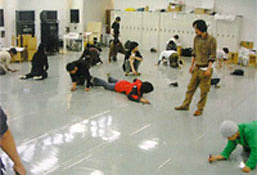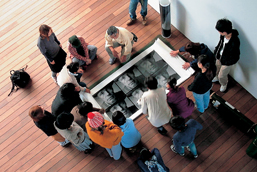DEPARTMENT OF INTERMEDIA ART
Department/course summary
The Department of Intermedia Art provides an environment that nurtures the development of a new breed of artists capable of expressing their own visions in their own ways, based on conceptualization skills unbound by preexisting techniques and media. Its goal is to develop students who have points of view that are open to society at large and take flexible and active approaches and who are able to communicate freely with individuals with diverse ideas and different sensibilities.
This department was established in 1999 to address new expressive domains previously covered only in fragmented ways by the university’s existing departments, to seek out and identify new expressive media, and to encourage works imbued with an awareness of the coming times. Students in the department are permitted significant latitude to study not just expression using visual and computer media, but beyond, encompassing performance art and other forms of physical expression, as well as installations that turn space itself into an expressive medium.
The Department of Intermedia Art seeks to approach the world of knowledge that human beings have created in new ways, focusing on expressive capabilities and considering the materials and techniques that support these capabilities as spatial, audio, visual, computer, language, physical, and other types of media, as well as learning about these from a comprehensive perspective.
Policy
Curriculum Policy
Faculty: In addition to the study of media within the domain of “fine arts,” such as drawing, handicrafts, photography, and film and video, the curriculum encourages practical learning of “what fine arts will come to mean in the future” through a study focused on the introductory tenets of various expressive media, such as the body, music, and computers. The basic principle is to nurture individuals demonstrating potential in the domain of creative work as well as in all Art Environment Support activities. The curriculum is designed in a way that the students can engage in creative work across domains in a cross-disciplinary manner in their respective studios, while learning through theoretical lectures.
Master: In continuation of Faculty education, the Master’s Program enhances specialization. Furthermore, the course content is not divided into narrow domains. In the first year, a common seminar called “Art in Context” is conducted. Students actively participate in a wide range of related fields, are exposed to a variety of special lectures and seminars not limited to Fine Arts, receive advice from diverse perspectives, and acquire in-depth learning about creative expression. A shared exhibition termed the Atlas Exhibition is also held. The course encourages students to proactively engage in projects that address issues at the cross-roads of modern society and in presentations about society that focus on practical orientation.
Doctor: Students who have obtained the Master’s degree can further expand their specialized research. They will conduct in-depth research in their own specialized field in conjunction with their creative work and study the theoretical research that underlies these activities. While engaging proactively in presenting their creative work and research, the students eventually complete a doctoral thesis.
Diploma Policy
Faculty:The Bachelor’s degree is awarded once the abovementioned curriculum policy has been fulfilled and the final year of graduation work has been thoroughly assessed.
Master: The Master degree is awarded once a review of the completed creative work and the commentary on the creative work or the graduation work has been conducted by the Thesis Review Committee comprising the department supervisor and supervisors in related fields and once it has been judged that the abovementioned Master curriculum policy has been fulfilled.
Doctor: The doctoral degree is awarded after a review of the thesis and the creative work has been conducted by the Degree Conferment Review Committee comprising the supervisor in the concerned research field and teaching staff in related fields and once it has been judged that the abovementioned doctoral curriculum policy has been fulfilled.
Curriculum
Educational and research structure
 The faculty in this department consists of specialists from a wide range of fields, including working artists, scholars, critics, art producers, and designers. While students currently learn through apprentice work that includes educational, research, and creative activities alongside professionals in venues around the world, the curriculum focuses on efforts to ensure that work is not sealed within individual studios. Dedicated studios and seminar rooms are available for handcrafts, photography, film and video, music, performance art, and desktop publishing.
The faculty in this department consists of specialists from a wide range of fields, including working artists, scholars, critics, art producers, and designers. While students currently learn through apprentice work that includes educational, research, and creative activities alongside professionals in venues around the world, the curriculum focuses on efforts to ensure that work is not sealed within individual studios. Dedicated studios and seminar rooms are available for handcrafts, photography, film and video, music, performance art, and desktop publishing.
Curriculum (undergraduate education)
Dramatic innovations in information and telecommunications technologies and economic globalization are dramatically transforming the meanings of works of art. These transformations concern the issue of expression. Human beings have only one life to live, and the various expressions conducted in that process cannot be separated from individuals’ own cultural, social, political, and economic contexts. Human behavior and awareness is determined by a complex network composed of the poles of urban vs. rural environments, shifting community organizations, transformations in industrial structures, and the tensions of international relations. Unconfined to the domain of art, expression deals with issues at the root of individual existence.
Accordingly, the Department of Intermedia Art seeks to be a place where students can learn and express themselves in cross-disciplinary ways, through the addition of diverse media including visual expression, physical expression, and computer literacy, as well as broad surveys of the traditional domains of art.
First-year theme:?Knowing yourself
In the first year, students familiarize themselves with the fundamentals of powers of expression while learning the characteristics of a wide range of media, including drawing, handcrafts, the body, photography, film and video, music, and design, revolving around practical training in the studio.
In addition, students improve their basic capabilities to read and comprehend, their imaginative capabilities, and their capacity to think, through intensive work in areas like language and computer basics.
Results of first-year studies are displayed to the public in Art Path Toride, an event staged and managed by students themselves.
Second-year theme:?Learning about others and the world off campus
In the elective studio curriculum in the first semester, students seek to develop their own independent methods of expression unconstrained by media types, by addressing diverse media in selective and complex ways and building on what they learned the first year in studios.
In fieldwork and editorial work in the second semester, students seek out off-campus venues and learn about the series of processes through the realization of a single work. This is done through activities ranging from in-depth research through discussion and exchange, conducted by participants with a wide range of personalities and opinions, based on group work.
Third-year theme:?Building relationships
Third-year students are assigned to individual instructors’





